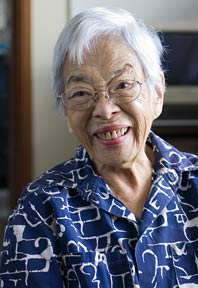Isabella Abbott facts for kids
Quick facts for kids
Isabella Aiona Abbott
|
|
|---|---|
 |
|
| Professor of Biological Sciences, Emerita, at Stanford University | |
| Personal details | |
| Born |
Isabella Kauakea Yau Yung Aiona
20 June 1919 Hana, Maui, Territory of Hawaii |
| Died | 28 October 2010 (aged 91) Oahu, Hawaii, US |
| Spouse | Donald Putnam Abbott |
| Children | Annie Abbott Foerster, daughter |
| Alma mater | Kamehameha Schools University of Hawaiʻi at Mānoa University of Michigan University of California, Berkeley |
Isabella Aiona Abbott (born June 20, 1919 – died October 28, 2010) was an amazing teacher and scientist from Hawaii. She was a phycologist, which means she studied algae (like seaweed). She was also an ethnobotanist, meaning she looked at how people and plants interact.
Isabella was the first native Hawaiian woman to earn a PhD in science. She became a top expert on the marine algae found in the Pacific Ocean.
Isabella's Early Life
Isabella was born in Hana, Maui, Hawaii, on June 20, 1919. Her full Hawaiian name was Isabella Kauakea Yau Yung Aiona. Kauakea means "white rain of Hana," and her friends called her "Izzy."
Her father was Chinese, and her mother was Native Hawaiian. Isabella's mother taught her a lot about edible Hawaiian seaweeds and the many different native plants in Hawaii. Isabella was one of eight children, the only girl and second youngest.
She grew up in Honolulu, near Waikiki. She finished high school at Kamehameha Schools in 1937. She then went to the University of Hawaiʻi at Mānoa and earned her first degree in botany (the study of plants) in 1941. She continued her studies, getting a master's degree from the University of Michigan in 1942. Finally, she earned her PhD in botany from the University of California, Berkeley in 1950.
Isabella married Donald Putnam Abbott, who was also a scientist. They had met at the University of Hawaiʻi. After they married, they moved to Pacific Grove, California. Her husband taught at Stanford University's Hopkins Marine Station. Back then, it was hard for women to get teaching jobs at universities. So, Isabella spent time raising their daughter, Annie, and studying the algae along the California coast. She even found ways to use local bull kelp (a type of seaweed) in recipes, like cakes and pickles!
Her Amazing Career
In 1966, Isabella started working at Hopkins Marine Station as a research assistant and lecturer. She wrote a book about the marine algae of the Monterey peninsula. This book was later made bigger to include all the algae along the California coast. In 1969, she won the Darbaker Prize for her work.
By 1972, Stanford University made her a full professor of Biology. This was a big deal because she was the first woman and the first person of color to hold this position there.
In 1982, both Isabella and her husband retired and moved back to Hawaii. The University of Hawaii hired her to teach ethnobotany. This field explores how people use plants in their culture and daily lives.
Isabella wrote eight books and over 150 scientific papers. She was known as the world's top expert on Hawaiian seaweeds, which are called limu in the Hawaiian language. She discovered more than 200 new species of algae. Some species were even named after her, like the Abbottella genus (a group of related species) of red algae. Because of her important work, people called her the "First Lady of Limu."
She received many awards for her contributions to science. In 1993, she got the Charles Reed Bishop Medal. In 1997, she received the Gilbert Morgan Smith Medal from the National Academy of Sciences. She was also chosen as a fellow of the American Association for the Advancement of Science in 1988.
From 1980 until her retirement in 1982, she was the G. P. Wilder Professor of Botany. Even after retiring, she continued her research as a professor emerita (a retired professor who keeps their title) at the University of Hawaii. She also helped lead the Bernice P. Bishop Museum. In 1997, she helped write an essay that led to improvements at the Kamehameha Schools.
In 2005, she was honored as a Living Treasure of Hawaiʻi. This award recognizes people who have made great contributions to Hawaii. In 2008, she received a lifetime achievement award from the Hawaii Department of Land and Natural Resources for her studies of coral reefs.
In 2023, the University of Hawaiʻi decided to rename its Life Sciences Building after Isabella Abbott. This was a unanimous vote, showing how much they respected her work.
Later Life and Legacy
Isabella Kauakea Aiona Abbott passed away on October 28, 2010, at her home in Honolulu. She was 91 years old. She is survived by her daughter, Annie Abbott Foerster, and a granddaughter, both of whom live in Hawaii.
To honor Isabella's important work, the University of Hawaiʻi created a scholarship. This scholarship helps students who want to study Hawaiian ethnobotany and marine botany, continuing her legacy of scientific discovery.
See also
 In Spanish: Isabella Aiona Abbott para niños
In Spanish: Isabella Aiona Abbott para niños
- Hawaiian ethnobiology
- Timeline of women in science

